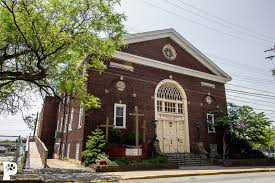History
History of the Christian Church of Wilkinsburg

The congregation was founded in 1901 when Wilkinsburg was growing as a suburban community for middle-management in the steel industry. The original building on Wood Street was burned to the ground on January 7, 1915 with only the sanctuary cross rising from the rubble, as photographed by the local newspaper. After a year of worshipping in a local movie theater, while being supported by the ecumenical community with Bibles and hymnals, the congregation built and moved to their present building in October 1916. The building is in the style of Georgian architecture and houses a beautiful sanctuary with natural lighting, a vaulted ceiling and dark wooden pews. An extension of the building with a gym and additional classroom space was added later in the 1950s.
Get an inside view of our church online in this beautiful virtual documentary series. The Wilkinsburg Sacred Spaces Tour was created by the Religious Architectural Heritage Committee of Preservation Pittsburgh to highlight the amazing architecture and history of Wilkinsburg’s churches. Because of Covid-19, a scheduled in-person tour was replaced by a video documentary project. Click here for more - Christian Church of Wilkinsburg is featured in the 3rd video in the top row!
Since the church is located directly across the street from the Wilkinsburg Senior High School, the congregation has maintained a strong ministry to the youth of the community. Though the forms of youth ministry have changed through the years, from youth group meetings, to after school programs, to basketball ministries, to summer jobs programs, youth ministry for and with the community remains an essential part of the congregation’s DNA. Currently, the congregation helps to facilitate a faith based, community collaborative to end youth violence in Wilkinsburg, called The Wilkinsburg Sanctuary Project.
In responding to community unrest after the assassination of Dr. Martin Luther King Jr., the church played a vital role in organizing the Wilkinsburg Community Ministry in 1968 to alleviate the root causes of poverty and racial injustice in the community. Slowly over the next four decades our Caucasian congregation started to receive African American members into its fellowship and leadership. Though the work of racial reconciliation was slow and often painful, the congregation now fully affirms and celebrates being an “inter-racial” family of faith. With the creation of a Racial Reconciliation Team in the 1990s, as well as the commissioning of three associate ministers who are African American in 2004-5, the congregation is considered a leader in racial reconciliation in our community and denomination.
With the collapse of the steel industry in the 1970s and 80s, the community of Wilkinsburg started to decline economically. In addition, white flight caused the decline of many businesses, as well as home-ownership in the community. By 1990, several Protestant churches left the community in the wake of white flight. Though our congregation was advised to leave the community by the church growth experts of that day, the church leadership made the historic and faithful decision to stay and continue our witness for Jesus in Wilkinsburg. They called , Rev. Janet Hellner-Burris in 1990 to lead us into a deepening of our inter-racial witness and service to the Wilkinsburg community which had been transformed from a middle-class, predominantly Caucasian suburb, to a multi-racial, multi-income urban community.
